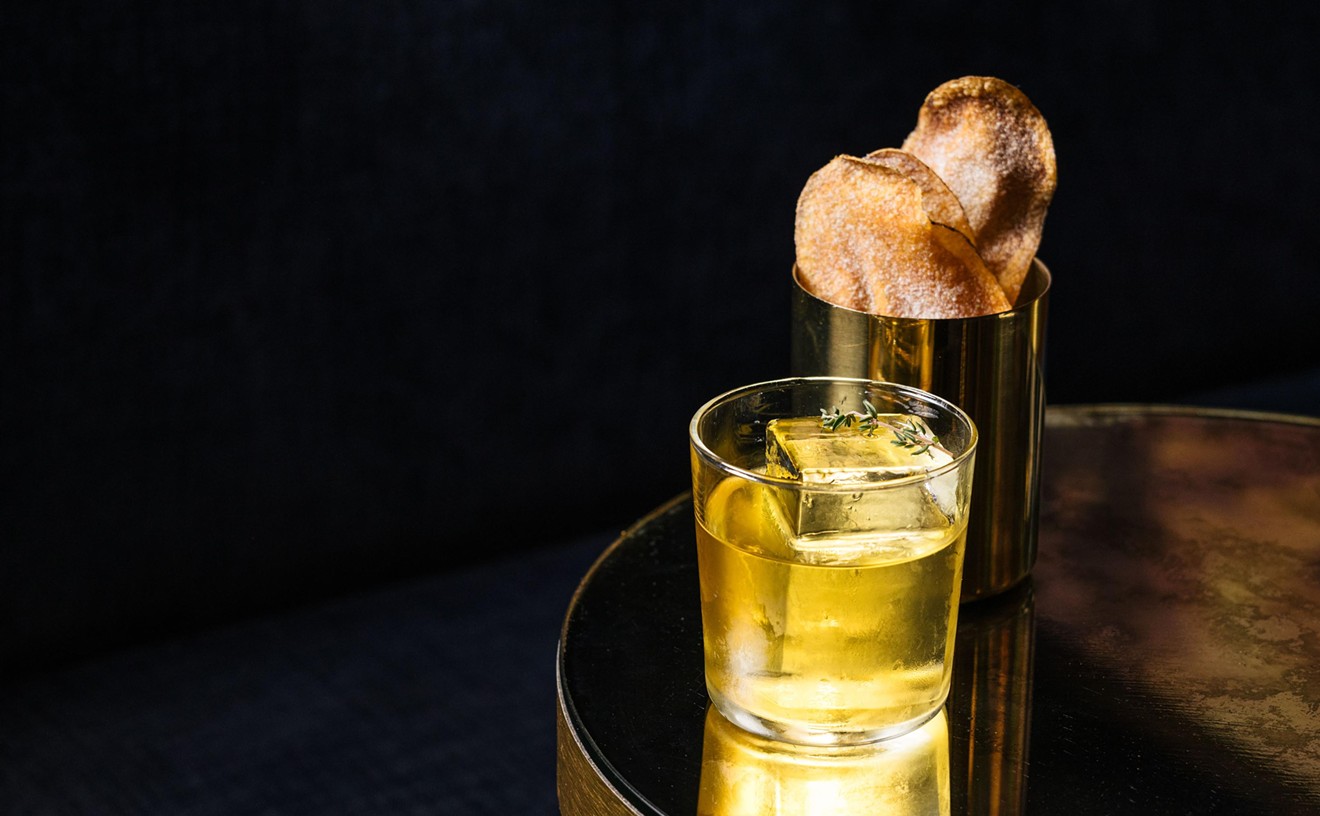For years, I've been keeping a mental checklist of things I'd like to see in downtown Phoenix, especially in the way of restaurants. So much seems ripe for the taking — there's no French, no Vietnamese, no Spanish. Being a shameless Japanophile, I've longed for an authentic izakaya where I can nibble on Tokyo-style comfort food, grab a beer, and unwind with friends.
But get this: My dream finally came true, and the reality is even better than what I'd imagined. The place is chic but unpretentious, affordable, and owned by one of Arizona's most highly acclaimed chefs. It's in a gorgeously renovated historic bungalow (circa 1899), right in the midst of Heritage Square, and it's open for lunch and dinner six days a week.
The food gods must be smiling.
Two-month-old Nobuo at Teeter House is the latest venture of chef Nobuo Fukuda, whose reputation skyrocketed during his tenure at Sea Saw, a Scottsdale culinary destination that closed last summer. There, he rose to national prominence with a 2003 Best New Chef nod from Food + Wine, and a 2007 James Beard Award for Best Chef, Southwest. It's fitting that his new spot is directly across from fellow Beard winner Chris Bianco's legendary pizzeria.
All that star power may seem intimidating, but the truth is, Fukuda's restaurant is very accessible — a smart move for these cash-strapped times.
While Sea Saw was a sleek jewel box of a fine-dining restaurant, with exquisite tasting menus served from the chef's counter (where I first became acquainted with Fukuda, years before I was the restaurant critic at New Times), Nobuo at Teeter House is not that kind of special-occasion spot. In fact, they don't even accept reservations here. It's fun to spontaneously swing by for a sit-down dinner, a casual lunch, or just a few drinks and small plates.
While Fukuda plans to eventually offer by-reservation-only omakase (chef's choice) dinners, à la Sea Saw, his four-seat, custom-made wooden bar currently is simply a hangout for drinking and noshing.
One night, I ordered up snacks like eggplant topped with bacon-miso, and enjoyed a cocktail called the "Smoky Bob," named after organic farmer Bob McClendon. It was an intriguingly smoky, faintly sweet, spicy concoction made with reserve mezcal, Cointreau, grapefruit juice, jalapeño, and McClendon's orange blossom honey. A tiny, emerald-colored shishito pepper was balanced on the edge of the chilled glass.
Besides craft cocktails, the drink menu also features several unique, hard-to-find Japanese microbrews (including a stout made with oysters), a dozen kinds of sake, and wine (Fukuda is renowned for creative pairings of wine with Japanese flavors).
For the impeccable quality, lunch here was a bargain. I can see myself becoming a regular for the salads: rosy, warm slices of duck, sweetened with soy-zinfandel sauce and fanned out over lightly charred Romaine; grilled marinated tofu with noodles and baby greens; or Vietnamese-inspired shrimp and rice noodles tossed with fresh shiso, for a Japanese twist.
Then again, I've been craving the guilty-pleasure sandwiches I ate here. One, made with soft shoku pan (Japanese white bread) from Tempe's Arai Pastry, contained juicy, crisp tonkatsu (panko-fried pork cutlet) and sticky, soy-based sauce, while another, served on housemade focaccia, revealed a whole panko-fried soft shell crab. Thinly sliced cucumber and lightly spicy kanzuri aioli offered coolness and a zesty contrast to rich, sweet crab.
Some dishes are available both day and night and can function as either an entrée or a shareable plate. Thin strips of candy-like marinated short rib, tucked taco-style into fluffy, slightly sweet steamed buns, are not to be missed. Same goes with braised pork belly buns, with pickled mustard greens to offset the unctuous, melt-in-your-mouth meat. Curry-scented lamb chops with a bright mango and fennel salad were succulent and satisfying to gnaw on.
True Japanese street food is a rarity in these parts, so I was happy to see a beer-friendly treat like pork- and seafood-studded okonomiyaki on the menu. Some folks might imagine Japanese food to be completely austere, as evidenced by the clean, simple flavors of sushi, but the flipside to the cuisine is epitomized by this over-the-top decadent creation, which means "cooked as you like it." (It's sometimes called a Japanese pizza or a savory pancake, which gives a sense of the round shape but not the sloppy-good appeal.) Drizzled with tangy sauce and creamy Japanese mayo, and topped with dried aonori seaweed flakes and salty, paper-thin shavings of dried bonito, it had a lot going on. I loved it.
Likewise, I hope they add takoyaki to the menu. It was a special one night, and was a much better-than-usual version of the ubiquitous snack. Typically, batter filled with octopus chunks is cooked in a special pan that forms it into small, bite-size balls. The version here eschewed the pan and was lightly fried, gently crisp, and molten on the inside. Yuzu aioli was a welcome alternative to traditional toppings (which would be identical to those served with okonomiyaki).
Tastes of what made Sea Saw famous are still evident in the cold raw seafood dishes, served in single-bite spoons lined up along a rectangular plate. Each one was thoughtful and intense, layered with dynamic flavors. Which one was my favorite? Fukuda himself posed the question to me — I'm not anonymous in this restaurant, after years of dining at Sea Saw — and I had a very difficult time answering.
Buttery hamachi, with ripe avocado, grapefruit, and white truffle ponzu, is a combination he invented at Sea Saw, and itstill blows my mind. Likewise, tender seared octopus perched on ripe tomato and hand-pulled mozzarella, with a dab of wasabi aioli and a pink peppercorn on top, is a familiar yet impressive combination.
I swooned at the sweetness of creamy sea urchin and Kumamoto oyster perked up with tomato water and wasabi oil, and licked the spoon after tasting housemade gravlax wrapped around a glazed almond, gilded with balsamic, basil oil, and a shard of pecorino Romano. Silky hiramasa was dazzling with lime-jalapeño fish sauce and crunchy taro slivers.
To finish, desserts were simple but thoughtful: chocolate tofu mousse with green tea ice cream (trust me, the flavors really do work together), fritters with sweet, creamy yuzu sauce, and unique frozen confections (jasmine tea ice cream, yuzu sorbet).
When I polished off my mousse, I looked up at the papier-mâché maneki neko, a waving cat perched above the bar. Businesses in Japan keep one on hand as a good luck charm to welcome customers.
Oh, yes, kitten, I'll be back for more.










